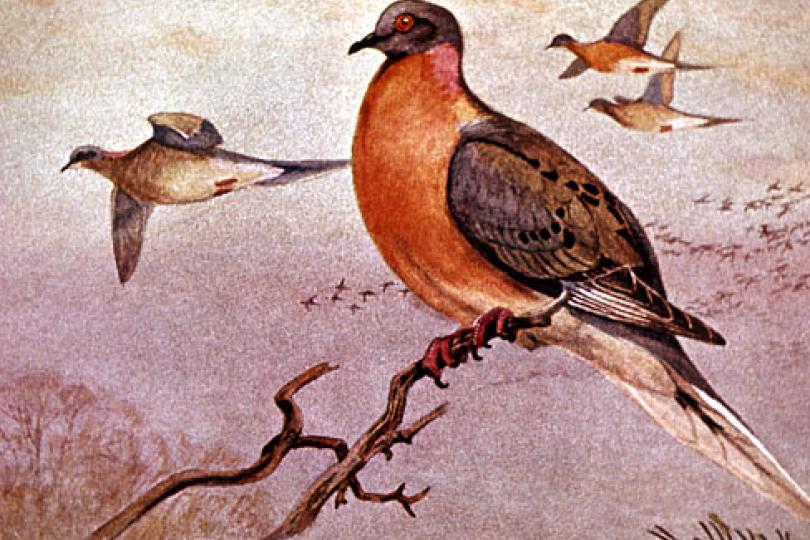The Passing of a Pigeon
This is the year for two notable, and related, anniversaries.
As we observe the 200th birthday of the national anthem of the United States, “The Star-Spangled Banner” by lawyer and amateur poet Francis Scott Key, there’s a second anniversary to remember. It’s a dark stain for our country, but one that few recall in these early decades of the 21st century.
It’s the 100th annual observance of the global extinction of the Passenger Pigeon, at one time the most abundant bird in North America, and possibly the world.
The last Passenger Pigeon seen on Earth died at the Cincinnati Zoo on 1 September 1914, now an archived mounted specimen at the Smithsonian Institution’s National Museum of Natural History in Washington, DC. I remember staring at this forlorn little creature in its display case when I was a boy, wondering how in the world we knowingly hurled such a common bird into oblivion. Sadly, “Martha” is no longer on display. With no visible reminder of its heartbreaking demise, how will children ever remember the lessons learned? Out of sight, out of mind ….
Imagine: the most common bird in the world’s history – in terms of its abundance, it accounted for more than a quarter of all birds in North America – driven into extinction by humanity’s stupidity and self-importance. Society had had all sorts of warnings about its pending doom, mostly ignored with the assumption that it had flown elsewhere. But then politicians got involved, thus ensuring the inability of conservationists to stop the slaughter.
For example, the Ohio State Legislature in 1857 filed a report stating, “The passenger pigeon needs no protection. Wonderfully prolific … it is here today and elsewhere tomorrow, and no ordinary destruction can lessen them.” Certainly, a damning statement about trusting politics over science in any era.
Indeed, the Passenger Pigeon was battered via extraordinary destruction by a witless and parochial species so-called by its Latin name, Homo sapiens, or “Wise Man.” An epithet has never been so ironically self-attributed!
By the 1880s, the pigeon was considered ecologically extinct. That is, its numbers had plummeted below any self-sustaining population, thereby making its physical extinction imminent without resolute human intervention … that never happened.
Why? Why? Why?
Several interwoven reasons. One: the commercial exploitation of the pigeon on a massive scale to feed to humans and pigs. Two: the development of technologies that allowed rapid news about the bird’s whereabouts (viz., the telegraph and the locomotive) in otherwise impenetrable wilderness. And three: the loss of its forested habitat.
How is all this related to “The Star-Spangled Banner?”
On the façade of the National Archives, that other repository of national heritage in Washington, are these words of warning: “The price of freedom is eternal vigilance.” Freedom in a nation of wondrous variety rings out, loud and strong, only because we remain heedful of threats to that freedom from within and from without our borders. That song resounds throughout the world as freedom’s hymn.
The National Archives dictum may be slightly reworked to highlight our country’s vast natural assets: “The price of conservation is eternal vigilance.” Our nation’s treasures – its biodiversity, its landscapes and vistas, its water and soil resources – are under a constant barrage of insults because we have too many people and too many “toys” plowing irrevocably into wild America without much thought about the generations to come.
It’s high time that we recognize that our freedom and our biodiversity are linked together. We cannot have an abundance of the former without an abundance of the latter.
Willfully permitting the extinction of a species, however diminutive, strikes me as the highest order of sin. Allowing such an event, whether explicit or inferred, is plain permission to extinguish an unbroken heritage – over 3.5 billion years old – from the stage of life on Earth. And, like all sin, this bad behavior had unforeseen consequences. Witness how our eastern forests changed in character and composition in the aftermath of the Passenger Pigeon’s demise – that, unhappily, coincided with our introduction of the chestnut blight into the eastern United States, the American Chestnut being one of the favorite food sources of the pigeon.
In 1947, Aldo Leopold, the “father” of wildlife management and author of “A Sand County Almanac,” remarked: “Men still live who, in their youth, remember pigeons. Trees still live who, in their youth, were shaken by a living wind. But a decade hence only the oldest of oaks will remember, and at long last only the hills will know.”
That sad day prophesied so long ago by Leopold is upon us. Few remember, and fewer seem to care.
H. Bruce Rinker, Ph.D.
Ecologist, Educator, and Explorer
hrinker@antioch.edu
This opinion piece originally appeared in The Roanoke Star.

